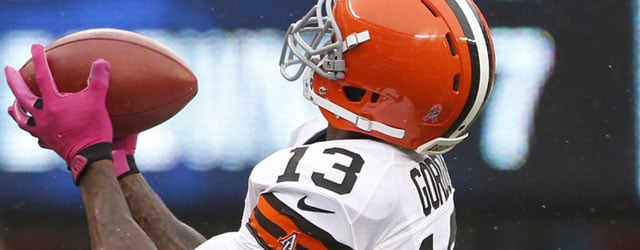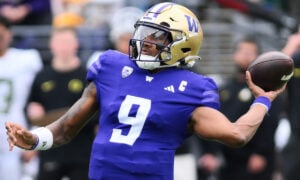Josh Gordon: The Next Dez Bryant?

In one of the worst keep secrets on twitter as of late, the Josh Gordon two game suspension finally came down this week. One of the main goals in dynasty fantasy football is to draft a player before they hit the level of superstardom and this setback may just be the final little push some owners needed in their quest to acquire him via trade or draft him cheaply in a start-up. After all, anyone can spend a first round pick on a player who is already a superstar – real value comes from drafting someone before they become elite. If you can spend a sixth round pick on a player who will become a star, you will create much more value than spending a first round pick on someone who is already a star. The first couple of rounds are filled with top-notch players and it is almost predictable when they will be drafted. There is much more strategy, though, in the following rounds to find future stars. Instead of seeing a player with an ADP of #7 overall being selected as high as #4, you may see a fantasy general manager select a player with an ADP of #50 overall being selected as high as #34. Identifying your guy, then trading up, trading back, or reaching to acquire him is essential to the strategy of building a fantasy football franchise.
Dez Bryant was a player being drafted in the middle rounds the past couple years. Since then, his value has increased in fantasy GM’s minds enough to place him in the late first to early second round range in twelve team leagues and almost certainly in the first round in sixteen team leagues. Calvin Johnson, A.J. Green, and Julio Jones are all being drafted ahead of Bryant. What makes Bryant stand out from that group? The fact that he was not a top-six NFL draft pick and was considered more of a wild card by NFL teams and fantasy owners alike. Bryant wasn’t drafted until Pick #24 in the NFL Draft after the Cowboys traded up three spots to select him. Over the past few years, fantasy general managers did not have to spend a very high draft pick on Bryant, either. This year, that will not be the case.
Being from the Washington D.C. area, I grew up hating the Cowboys. Despite that fact, I put my fandom aside when it comes to fantasy football. Tony Romo has taken me to a couple championships, while DeMarco Murray helped me win my local dynasty league last year. Personally, I believe Bryant has received an unfair label in regards to his off the field and character issues. The only quarrel I have with Bryant is the jersey he wears. Other than that, he is a legitimate superstar (no pun intended).
In October of 2009, Bryant was ruled ineligible to continue his Junior season for the Oklahoma State Cowboys, because he lied about meeting Deion Sanders. A month later, he declared for the NFL draft. In his rookie season with Dallas, Bryant saw 72 targets, hauling in 45 of them for 561 yards and 12.5 average yards per catch. He added six touchdowns to his stat line before fracturing his ankle in week 13 against the Indianapolis Colts. Averaging those numbers over a full and healthy season, he would have seen 89 targets, 55 catches for 690 yards and seven touchdowns.
Since Bryant’s rookie season, his fantasy numbers have increased each year. In 2010, Bryant recorded 103 targets, 63 receptions, 928 yards, and nine touchdowns. Last year, his stats elevated once again. In 2012, he tallied 138 targets, 92 catches, 1,382 yards and 12 touchdowns, ranking him as the third best wide receiver in fantasy football.
Since you will not be able to draft Bryant in the middle rounds this year, you should ask yourself, “who will be the next bargain superstar wide receiver?” In my opinion, it is unquestionably Josh Gordon.
I am a sucker for “measurables,” and the comparisons between Gordon and Bryant are glaring.
|
Dez Bryant |
Josh Gordon |
|
|
Height |
6’2” |
6’3” |
|
Weight (Pounds) |
220 |
225 |
|
Arm Length |
34” |
33.3” |
|
Hand Size |
9.75” |
10” |
|
40 Yard Dash (Seconds) |
4.52 |
4.52 |
|
Rookie Year Target/Gm |
6 |
5.93 |
|
Rookie Year Rec/Gm |
3.75 |
3.13 |
|
Rookie Year Yd/Gm |
46.75 |
50.31 |
|
Rookie Year TD |
6 |
5 |
Gordon’s body is practically a clone of Bryant’s. They both are tall, muscular, fast, prototypical NFL receivers, but that’s not where the similarities end. You must compare Gordon’s first season with Bryant’s rookie season to see the similarities so you can project what Gordon will be in his sophomore year and beyond. Their rookie years are as astonishingly similar as their body type. They both were targeted about six times per game in their debut seasons. Gordon’s catch per target was slightly less than Bryant’s, which you can attribute to having a sub-par quarterback in Brandon Weeden. When Bryant joined the league, Romo was already entrenched as the starter for the Dallas Cowboys. Gordon’s yards per catch are superior to Bryant’s rookie season’s yards per catch as well. Gordon averaged over 50 yards per game and had 12 catches of 20+ yards. Bryant averaged slightly less yards per game, and had just eight catches of 20+ yards as a rookie. So in many ways, Gordon had the better rookie season.
His quarterback situation should not scare you, either. He put up serviceable numbers despite his imperfect signal caller. Brandon Weeden should improve along with the Cleveland Browns offense, as made evident by the second half of the season. Weeden improved his completion percentage to over 55% in each of his last six games. Trent Richardson will continue to see eight man boxes, which should guarantee Gordon single man coverage for most of his foreseeable career.
Projecting a player’s career in the NFL is a flawed objective by even the greatest NFL general managers. If those GM’s do not accomplish their goal every time, how do we as fantasy GM’s? Gathering as much information about specific players you want to target is vital. If you see Gordon still available in the fifth or sixth round of your start-up, don’t hesitate to enhance your receiving corps. If you’re in an established league, capitalize on Gordon’s embryonic value, and make a trade for him.
Follow me on Twitter: @karlsafchick


































































